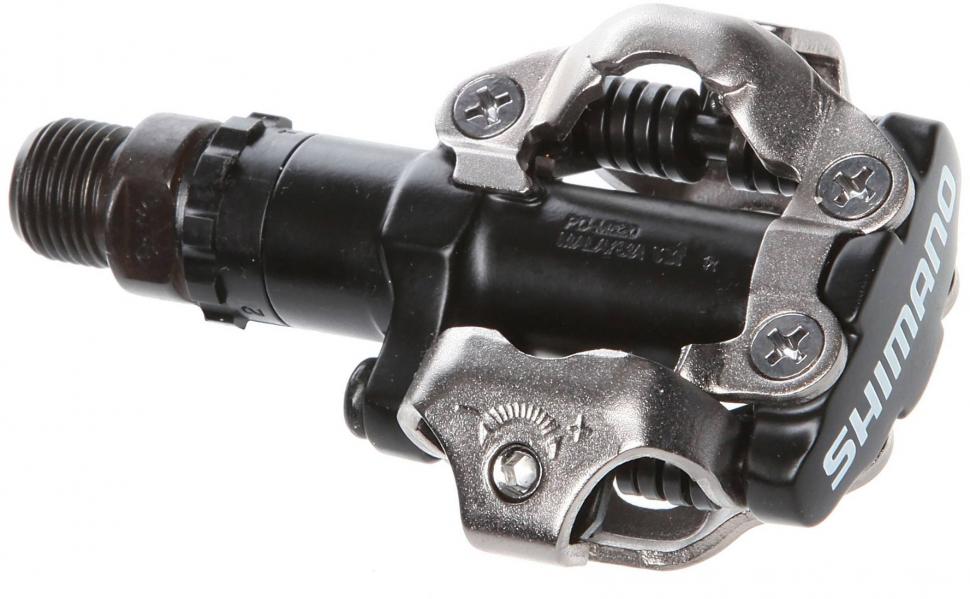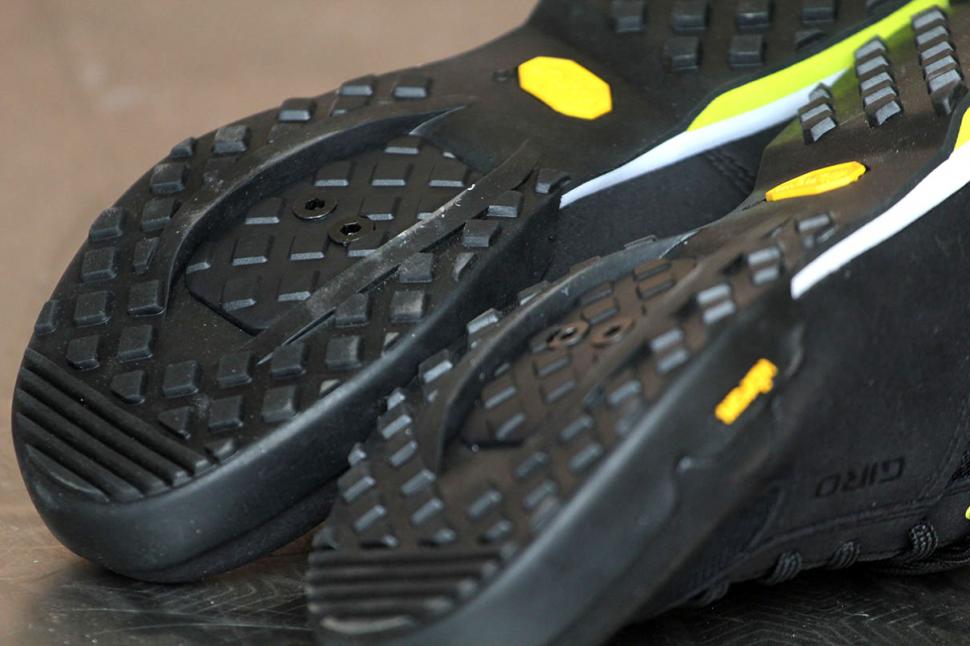Proper cycling shoes help keep your feet comfortable, improve power transfer and let in air to cool your feet on hot days. They’re an under-rated part of the cycling wardrobe and needn’t cost the earth.
The key to the function of cycling shoes is the sole. Cycling shoes have soles that are substantially stiffer than those of regular shoes or trainers. They don’t need to bend for walking, so they can be very stiff. That spreads the force you’re putting on the pedals around your foot and stops your foot uncomfortably bending at the edges of the pedal.
Let’s take a look at cycling shoes from the sole up.
Soles
A cycling shoe sole is stiff because it’s made of some sort of rigid plastic, often reinforced with fibreglass or carbon fibre. Most cycling shoe soles have threaded inserts so you can attach cleats for use with clipless pedals, though there are a few retro-styled shoes with smooth soles for use with clips and straps.
There are two types of soles for clipless pedals. Road racing-style shoes have three threaded inserts for a cleat that sits on the outside of the sole. Mountain bike style shoes take a two bolt cleat that sits in a recess in the sole tread so that the shoes are easier to walk in when you have to get off the bike.
Shoes for three-bolt cleats are great for rides where you don’t get off the bike for more than a cafe stop. If you want to walk around in between periods on the bike, go for two-bolt shoes.
Three-bolt soles usually have a couple of lumps of rubber under the heel and toe to make it slightly easier to walk in them, but they only improve things a little.
Uppers
Cycling shoe uppers are made from many materials including real leather or suede; synthetic leather or suede; and nylon mesh. They are usually stitched together from various panels of material, but some high-end shoes have the upper moulded in one piece, which saves weight. Look for seams reinforced by double lines of stitching at the edges of the panels.
The main body of the upper will have padding, reinforcement and stiffening in various places. The most significant stiffening is usually around the heel. This heel cup is shaped to hold your heel down in the shoe so it doesn’t slip on the upstroke as you pedal. The toes are usually reinforced against scuffing, especially in shoes intended for mountain biking. There’s usually padding at the heel and top of the shoe for comfort.
Some high-end shoes have uppers that can be moulded to more precisely fit your feet. Your dealer warms them, usually in a special oven, and then you put them on and buckle them up. As they cool they’ll take on the shape of your feet.
Closures
To keep them on your feet shoes need to be fastened. The old school way of doing this was with laces, but most cycling shoes now use Velcro straps, buckles, dials or some combination. Laces have made a bit of a comeback in the last few years, though, with some very high-end models using sophisticated string to keep them snug.
Shoes with laces will usually have a Velcro strap to cover the knot or some sort of ‘speed laces’ with a buckle to hold the laces in place and a place to tuck the free end. Either way, you don’t want any dangling string that can get caught in your chain or wrapped round the pedal axle so be sure to there are no loose dangly bits to get snagged. They may be a bit fiddly, but laces allow you to spread the tension evenly over your foot, which can make lace-up shoes very comfortable.
Velcro straps are the cheapest option. There are usually three along the top of the foot and you simply pull them tight and cinch them down. They’re quick and easy and they hold the shoe firmly im place, but as there are only three of them it’s easy to overdo tightening one and end up feeling like part of your foot has been clamped. Tighten them gently.
On more expensive shoes you’ll find a ratchet buckle replacing the top strap. The advantage of a ratchet is that it’s very easy to adjust the tension as you ride, either to tighten it for a big effort or loosen it off if your feet are getting tired.
On some high-end shoes you’ll find one or two dials that tighten very fine plastic-covered steel cables. In effect this is the high-tech answer to laces, spreading the tension around the top of the foot. The idea first appeared as the Boa closure; several shoe manufacturers now use it or their own versions. Like ratchets, wire-dial closures allow you to adjust the tension while you ride.
Insoles
Inside the shoe you’ll find an insole that cushions your foot and spreads the loads around. These vary in sophistication from a simple layer of foam to liners with multiple densities and adjustable support to heat-mouldable insoles that can be shaped to fit your foot. You can also buy new insoles to improve the fit and comfort of your shoes.
Ventilation, warmth and waterproofing
All that pressure through your feet can lead to them getting hot on warm days. As well as weight reduction, that’s why some shoes use lightweight mesh to let air in and cool your feet. Many shoes also have ventilation holes in the soles, though these can make you too cold in the winter. A strip of duct tape fixes that.
Speaking of winter, you can get shoes specifically-designed to keep your feet war and dry during the cold and wet months. They usually have a breathable, waterproof Gore-Tex liner and a layer of insulation. That means they’re not cheap, but they’re worth it if you want to carry on riding through the winter. Pro tip: buy them in the spring when they’re heavily discounted and put them away for winter.
Women’s shoes
In general, women have narrower ankles than men and smaller feet. Women’s shoes are therefore a slightly different shape, and some models are available in smaller sizes than the 36 that’s usually the lower limit of men’s ranges.
What do you get for your money?
It pays to shop around; shoes are rarely sold for full RRP. At actual prices of around £50 you start getting ratchet buckles for easy tension adjustment.
Want something stiffer and lighter? The cheapest shoes we’re aware of with carbon fibre soles will set you back £65, and you don’t have to pay much more for heat-mouldable soles.
From there on up shoes generally get more orientated toward racing, with a few exceptions like winter boots and expedition mountain bike shoes. That also means soles usually get stiffer and the whole shoe lighter. The light, high-strength materials needed to achieve that are expensive, which pushes up the price of the shoes. Won the lottery? Check out the handmade Assos G1 shoes with carbon fibre soles, kangaroo leather uppers, Boa closure and every clever detail you can think of. A snip at £370.
Five great shoes for beginner cyclists
Triban RoadC 100 shoes — £29.99
Shoes with two-bolt SPD cleats are great for riders who are new to cycling shoes because they're easier to get into and allow you to walk around off the bike. These cycle touring shoes from Decathlon are a bargain, with a Velcro strap to stop the laces getting tangled in your bike and a reflective insert in the heel for visibility.
Muddyfox RBS100 — £30
My eyes! It's okay, these budget road shoes from Muddyfox are also available in a snazzy white, red and black colour scheme for those who aren't sufficiently extrovert for screaming neon.
They have a two-strap closure, with a very broad strap across the top to spread the tension over your foot, and Amazon reviewers say the sole is plenty stiff. For just £30, they do the job.
FWE Pitch Sport — £49.99
For £60 these SPD shoes from the Evans store chain look like a decent deal. There's also a road-specific version for the same price.
There are plenty of other shoes for under £50 at the moment in Evans' sale.
Giro Petra VR — £59.99
While there's always going to be a time and a place for super-stiff lightweight road shoes, sometimes that's not always what's required, or desired. The Giro Petra VR Shoes are designed for those times when there's going to be a fair bit of walking as well as riding, and when a more low-key looking shoe may be the thing. But they're still technical.
Officially in Giro's 'dirt' section of the company's website, the Petra VR is more a touring or casual shoe, rather than a technical mountain bike shoe. They lace up, have a Vibram sole, and feature a removable plate under which lurks SPD attachment points, but they are styled much more casually.
The men's equivalent is the Rumble VR.
Read our review of the Giro Petra VR
Shimano ME2 — £32.00 - £49.99
Happy customers report comfort on three-hour-plus rides from these three-strap mountain bike shoes which have fibreglass reinforced soles for comfy pedalling. A rubber outsole provides grip when you're off the bike, so these can be used for strolling around as well as riding.
Fizik R1 Infinito Knit — £249.95 - £359.99
Only kidding!
About road.cc Buyer's Guides
The aim of road.cc buyer's guides is to give you the most, authoritative, objective and up-to-date buying advice. We continuously update and republish our guides, checking prices, availability and looking for the best deals.
Our guides include links to websites where you can buy the featured products. Like most sites we make a small amount of money if you buy something after clicking on one of those links. We want you to be happy with what you buy, so we only include a product in a if we think it's one of the best of its kind.
As far as possible that means recommending equipment that we have actually reviewed, but we also include products that are popular, highly-regarded benchmarks in their categories.
Here's some more information on how road.cc makes money.
You can also find further guides on our sister sites off.road.cc and ebiketips.
Road.cc buyer's guides are maintained and updated by John Stevenson. Email John with comments, corrections or queries.









































































































































